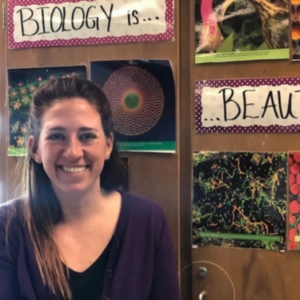“Inside the Classroom” with Brittany Hubert
December 9, 2019

Meet Brittany Hubert, an 11th grade biology teacher, whose story we share in our 2019 Annual Appeal.
Why did you become a teacher, and where are you now?
I can remember wanting to be a teacher as far back as elementary and middle school. I would come home after school and reteach the concepts I’d learned to my class of stuffed animals—I even had a grade book! Then in 6th grade, I had the most amazing science teacher, Ms. Hedrick. She was so passionate and energetic and genuinely excited about the content she was teaching. Years later, when I would start teaching, I would strive to emulate Ms. Hedrick in my own classroom until I could develop my own “teacher identity.”
In high school and college, I veered away from the teaching path. Instead, I dove deeper into science, working in two separate biological sciences research labs and considering careers as a public health worker, epidemiologist, doctor, or research scientist. On a trip to Ghana that centered on surveying public health systems, I had an opportunity to teach integrated sciences at a middle school called Zo-Simli-Naa Girls’ School. This is where my passion for teaching was rekindled. I loved the relationships that I fostered with the students and how interested they were to learn new ideas and apply them to experiences they had and observations they made in their own lives.
In my final year of college, a very impactful mentor that had worked with me throughout the last four years convinced me that I didn’t have to wait until the end of a career in one of the aforementioned pathways to become a professor; he reminded me that teaching in middle school or high school was also an option—albeit not one that I had considered in the last 10 years. So in my final semester of college, I changed all my plans and applied to the College of Education at University of Louisville through a program called Teach Kentucky.
As I’m now in my 6th year of teaching Biology and Anatomy and Physiology, I am beyond grateful that I was able meet so many excellent mentors and to have been through these special experiences that guided me to a career that I am now so passionate, energetic, and genuinely excited about—just like Ms. Hedrick and so many other teachers that I encountered along the way!
How did you become familiar with BSCS Science Learning?
During my second year teaching in Jefferson County Public Schools (JCPS), the district science department lead advertised the STeLLA® research program that would be taking place over the following two years. I signed up for three main reasons: first, we got paid a stipend; second, my history in research made me very intrigued by the research component of the program; third, I felt like I needed more guidance in effective science teaching—there were so many areas in which I knew I needed improvement but had no idea where to turn for guidance.
What would you say to a teacher who is considering whether or not participate in the STeLLA program?
What are you waiting for?! Seriously though, STeLLA has been the single most impactful experience in my career as a teacher. My entire approach to teaching has changed—for the absolute better—since starting STeLLA. The interactions I have with my students, the interactions my students have with each other, my excitement about teaching the content, and the success I have while teaching the content and my student have while interacting with the content have all improved tremendously since I’ve implemented STeLLA.
What is one educational resource or tool that you love and cannot live without?
EDpuzzle is my favorite resource to use to supplement the lessons that have been developed my BSCS and JCPS teachers as well as other lessons that I’ve developed myself. It’s a way for me to upload videos and embed quizzes within the videos. This is very helpful for my students who have a hard time focusing for long periods of time or who need a review!
What excites you most about the future of science education?
The shift from “sit-and-get” learning to lessons that are more interactive and that encourage students to think critically and develop their own ideas and independent thoughts. I’m constantly surprised by the ideas and questions my students have about how what they’re learning applies to current events in the science world!